
Updated March 22, 2018
Lynn Gustafson had always been skinny. Four friends, on the other hand, were in a constant battle with excess weight. Frustrated, they asked for her advice on how to keep the pounds off. Her secret stunned them: Gustafson had a medical condition called torus palatinus, which caused bony growths on the roof of her mouth—making it flat rather than concave. As a result, she could only take small bites, and had to chew her food thoroughly. So Gustafson took her friends to a dental lab in Washington, where they lived, and had them outfitted with oral devices that mimicked her condition. Every time the friends ate, they used the retainer-like apparatus. Within weeks, the whole clan had dropped pounds.
Gustafson patented the idea in 1999. Since then, she has died, but her invention, SmartBite, hit the market in 2010. The premise is simple: the less food people can fit in their mouth, the slower they have to eat, which is better for losing weight—because the brain has enough time to recognize fullness signals from the gut. “A lot of people think [satiety] is like flipping a switch,” says William Longley, CEO of Scientific Intake, which makes the device. “But it’s a lot more gradual.”
This evolving understanding is the result of a slew of studies, and has spawned innovative products to help people lose weight by getting them to eat slower. This approach puts the focus squarely on how we eat, rather than just what. “The problem with fast food is not so much the food, it’s the fast,” says Dr. Arya Sharma, scientific director of the Canadian Obesity Network, and professor at the University of Alberta in Edmonton. It takes roughly 20 minutes for the brain to sense fullness (though it varies). “In those first 20 minutes, you can pretty much eat as much as you want,” explains Sharma, referring to the time before the brain receives satiety signals from the gut. “Twenty minutes later, you’ll hope you hadn’t. But it’s too late.”
Fast eaters often have two things in common: they overeat, and are overweight. In the March 2010 issue of the journal Obesity, researchers from the University of Philadelphia demonstrated that children who exhibited a “rapid eating style” were at higher risk of becoming obese. In late 2008, the British Medical Journal published a Japanese study showing that men and women who ate quickly and until they felt full were the heaviest and had the highest BMI compared to people who ate slowly or stopped eating before they reached satiety—regardless of factors such as smoking, alcohol consumption, occupation or activity levels. Another study in the January issue of the Journal of Clinical Endocrinology and Metabolism revealed that “anorexigenic” or appetite-suppressing hormones were more pronounced when an individual ate slowly. “Thus,” the authors concluded, “the warning we were given as children that wolfing down your food will make you fat may in fact have a physiological explanation.”
One of the easiest ways to eat slower is by chewing more, which is the key to SmartBite. “A lot of people just take a bite of food and then shoot it down,” says Longley. “You can’t do that with this in your mouth.” Scientific Intake says its market studies show that an individual who uses the device at every meal will lose at least seven pounds a month. Their research also indicates a 23 per cent reduction in food intake among clients. A microchip in the device monitors temperature and darkness to indicate how often it’s used; the data can be accessed by a support network.
Another device called the Mandolean works by verbally and visually encouraging users to eat slowly. A small computer screen that looks like a GPS is attached to a mini-scale. Users place their food on a plate, which goes on the scale. As they eat, the computer tracks the amount of food consumed relative to a healthy eating rate. Charts on the screen prompt users to have a bite; if too much is taken or too quickly, the computer says so. “If you use it every day for three to four months, your behaviour is normalized,” says Cecilia Bergh, CEO of Mando Group. “Your brain responds to new signals regarding when to stop eating.”
Of course, there are more low-tech ways to learn to eat slowly, says Sharma. “Use smaller plates and smaller utensils, lay down your fork between bites, chew every bite 30 times.” He also warns against having a meal while watching TV or working at the computer, which leads to mindless eating. Sharma notes that fast eating isn’t the only factor in weight gain. Drinking sugary beverages or excess snacking may be the problem, in which case slow eating won’t help with weight loss. Still, Sharma says the principle of eating slower as a way of controlling the pounds and reducing caloric intake is a good one. Adds Longley, “The only risk is weight loss.”